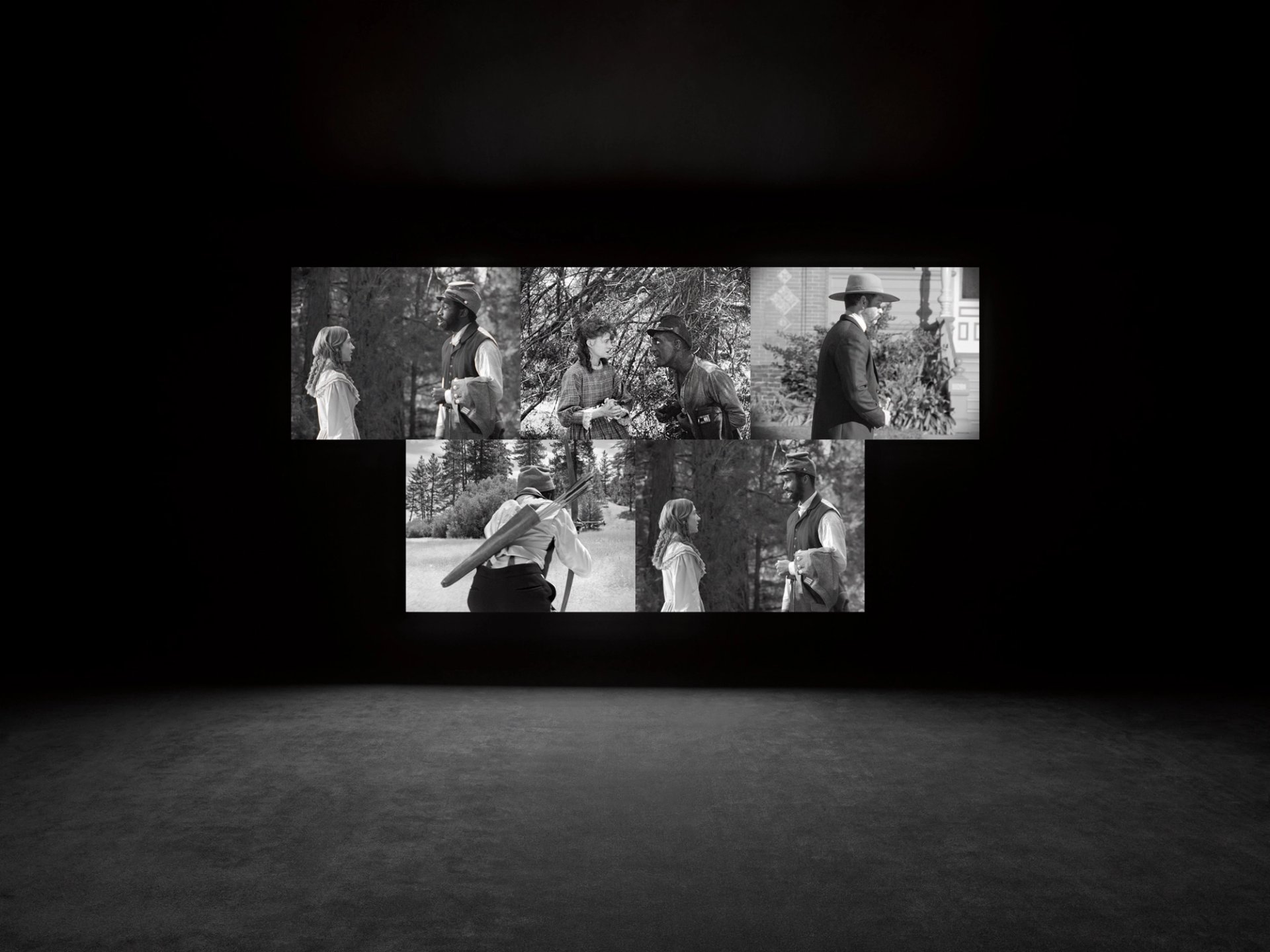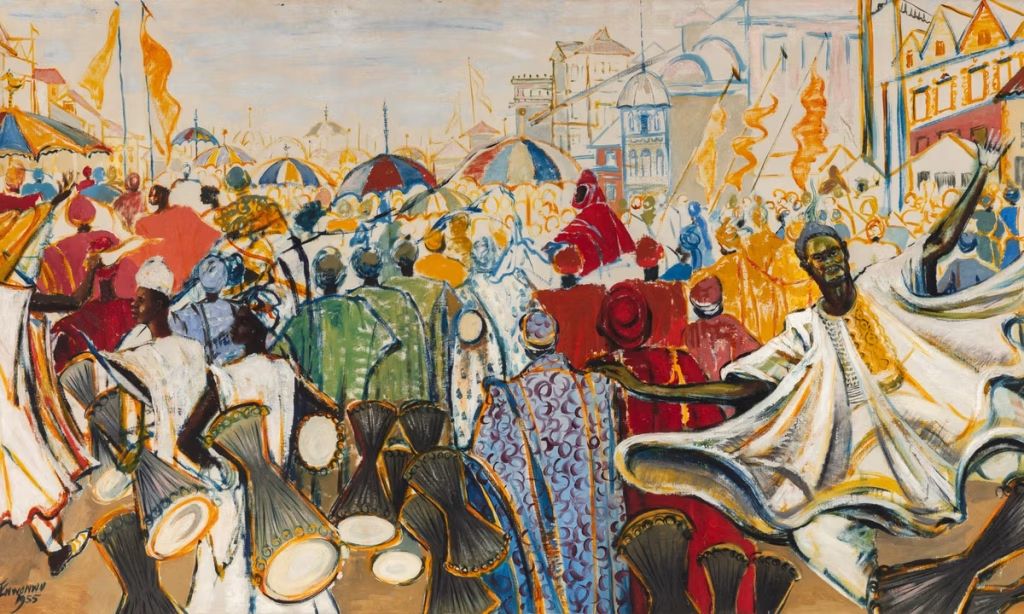For this year’s Black History Month, the theme is Standing Firm in Power and Pride, honouring the resilience, innovation and fortitude of Black people in the UK and beyond. It celebrates the community’s contributions across many fields, including the arts and culture, as reflected in a selection of brilliant new exhibitions. These range from explorations into the artists and groups who shaped the Modernist art movement in Nigeria to the importance of recording culture and histories, as seen with Jennie Baptiste’s seminal works at London’s Somerset House and the stories of the Caribbean Windrush generation in Cambridge. In today’s shifting—and often polarising—social, political and economic landscape, these exhibitions highlight the power of community, joy as resistance, growth and reflective meditation.
Nigerian Modernism
Tate Modern, London, 8 October 2025-10 May 2026
Ben Enwonwu, The Dancer (Agbogho Mmuo – Maiden Spirit Mask), 1962
© Ben Enwonwu Foundation, courtesy Ben Uri Gallery & Museum
This is the first major UK exhibition to explore the development of Modern art in Nigeria, highlighting artistic groups like the Mbari Club and the Zaria Art Society, which led the movement during the transformative 20th century. This period saw Nigeria freed from colonial rule in the 1940s and experience the optimism of independence from British control in the 1960s, followed by the subsequent political, social and economic changes in post-independence Nigeria.
Nigerian Modernism takes viewers on a journey through various Nigerian cities including Lagos, Enugu, Ibadan and Zaria, as well as European cities such as Munich, Paris and London. The exhibition features more than 250 works, including paintings, sculptures, ceramics and textiles by more than 50 artists such as Ben Enwonwu, Ladi Kwali, El Anatsui and Bruce Onobrakpeya. Their trailblazing works, spanning a 50-year period, introduced an era of cultural revolution. These artists envisioned a brighter future and established a visual language that reflected the country’s national identity and cultural heritage, incorporating Nigerian, African and European techniques into their dynamic artistry. More
Stan Douglas: Birth of a Nation and The Enemy of All Mankind
Victoria Miro, London, until 1 November 2025

Installation view, Stan Douglas: Birth of a Nation and The Enemy of All Mankind, Victoria Miro
© Stan Douglas. Courtesy the artist, Victoria Miro and David Zwirner
With a title evoking D.W. Griffith’s controversial 1915 film The Birth of a Nation—regarded as one of Hollywood’s most infamous films—Stan Douglas presents his new 13-minute video across five screens. Known for remixing and blending fact with fiction, the multi-channel video installation centres on a violent moment from Griffith’s film involving Gus, a white actor in blackface, Flora, a young white woman, and the KKK. On one screen, Douglas shows the original scene, while the other four feature remakes including two new Black characters, Tom and Sam. Like Gus they are Confederate captains, though their identities are blurred. Through this, Douglas explores themes of misidentification and racial perception.
Accompanying the video is the photo series The Enemy of All Mankind: Nine Scenes from John Gay’s Polly. The work is inspired by Gay’s censored 18th-century opera Polly, which satirises England’s colonial ambitions and destructive tendencies. The artist staged scenes from the comic opera, offering a radical alternative way of living, away from oppressive laws that ruled the colonial world, and to some extent, do the same in today’s society. More
Jennie Baptiste: Rhythm & Roots
Somerset House, London, 17 October 2025-4 January 2026
Jennie Baptiste, Pinky, 2001
© Jennie Baptiste
Here the trailblazing photographer Jennie Baptiste, whose three-decade career has captured pivotal moments in fashion, music, the energetic spirit of youth culture and life within the Black diaspora in London, receives her first UK solo exhibition. Part of Somerset House’s 25th birthday celebrations, it showcases Baptiste’s well-known works alongside rare and previously unseen images from her personal archive, highlighting her significant contributions to contemporary photography. Baptiste’s passion for music is a core influence, reflected in portraits of legendary artists like Jay-Z, Nas, Estelle, Biggie Smalls, Roots Manuva and Ms Dynamite, as well as works exploring dancehall, extravagant Brixton fashion and Afro-Caribbean hairstyles.
“Working with Jennie has been an incredibly collaborative and fulfilling process,” the exhibition’s curator, Kinnari Saraiya, tells The Art Newspaper. “I’ve learned so much from the stories behind her images, as well as from her experimental darkroom techniques, which turn the space into a site of invention. In curating this exhibition, I aimed to show how her images celebrate presence, creativity and identity, balancing iconic artist portraits with experimental works that connect music, style and resistance histories. We hope visitors leave with a better understanding of how fashion, music and photography have served as powerful forms of expression for Black British youth, and why Jennie’s work continues to resonate.” More
Legacies of Windrush in Cambridge
The Museum of Cambridge, 26 April 2025-26 January 2026
Celebrating the Caribbean Windrush generation in Cambridge, this exhibition highlights their significant impact both locally and across the UK. It is the first show of its kind to focus on overlooked stories from this lesser-known chapter of British history. Curated in partnership with Carol Brown-Leonardi of the African Caribbean Research Group (ACRG) and the Museum of Cambridge, alongside student curators of Caribbean heritage from the University of Cambridge, it reveals untold stories of the Caribbean community that arrived in the 1950s and 1960s. These include the connection between the Cambridge West Indian Cricket Club and Cambridge’s first Black-owned pub, the Midland Tavern, uncovered during research for the exhibition.
“This is a landmark exhibition for the museum,” says Alex Smaridge, the museum’s director. “We worked closely with the Caribbean community to ensure their stories are told front and centre.”
As recording cultural and social history becomes increasingly critical in preventing its loss, Legacies of Windrush in Cambridge features oral histories from Caribbean elders, including local newsagents, steelpan players, pub owners and others who share their experiences and legacies through the arts, music, food, religion, sport and community. These stories present themes of family, place, joy and community. The exhibition also displays personal items such as photographs, textiles and steel pans loaned by community members. “Working on this exhibition was an extraordinary experience that enabled us to understand the resilience and determination of the Windrush pioneers,” Brown-Leonardi adds. More
Edward George: Black Atlas
The Warburg Institute, London, 10 October 2025-17 January 2026
Edward George, Black Atlas (still), 2025, from Image of the Black archive, Warburg Institute
Courtesy of Warburg Institute © the artist
In the 1960s, French-American art collectors and philanthropists Dominique and John de Menil launched the Image of the Black archive, an archival project with a collection of around 30,000 photographs documenting people of African heritage from ancient times, early European art, Modern art and the civil rights era. The archive was accumulated between the 1960s and 1990s and developed as a response to the Civil Rights movement in the US. Showing for the first time in the UK at the Warburg Institute, the archive will be explored in the new exhibition Black Atlas by Edward George, a multidisciplinary artist and founder of the Black Audio Film Collective.
Created during George’s research residency at the Warburg Institute, the show will feature a newly commissioned “poetic image essay” film, inspired by the Image of the Black archive, and serving as a site for cultural history and reflection. “For me, the archive was a story of ghosts in visual fragments,” George says. “Black Atlas maps how those images move through time. There is an aspect of invention, as you’re giving fictional lives to people on the borders of history.” Also on display are triptychs of collaged image panels, unfolding as an evolving visual history that will change throughout the exhibition. More
